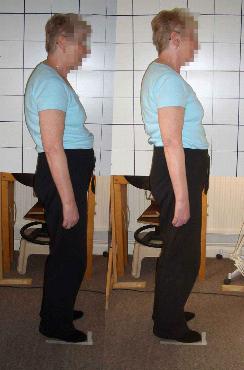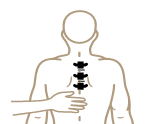What happens in a lesson?
‘There is an overall flexibility and tonic ease of movement, greater freedom in the action of the eyes, less tension in the jaws, more relaxation in the tongue and throat and deeper breathing. There is also a sense of weightlessness and diminution of the effort previously thought necessary to move one’s limbs. Activity now becomes free and flowing, no longer jerky and heavy with strain.’
Edward Maisel, Director of the American Physical Fitness Research Institute.
Alexander Technique sessions show you how to sit, stand and move in a more balanced and co-ordinated way, so that back and neck pain are relieved.
In a surprisingly short space of time The Alexander Technique will unravel you, showing us how to regain your natural posture and the easy co-ordination.

With practical help you begin to understand how to stop harmful habits of posture and co-ordination. This is usually done through a combination of demonstration, verbal instructions and gentle guidance with the hands. The latter is especially important to give you a reliable experience of what it actually feels like to use your body correctly. As a result you allow the body to work in a freer and more natural way. Once this has become established it is possible to apply the principles to more complex and demanding situations.
The most frequently asked question is “How many lessons do I need?
All teachers work differently and as an experienced teacher, I can show you very simple skills that quickly allows you to release tension and to use your body in a more efficient, less tiring way. My unique 10 stage programme can show you how to regain your basic co-ordination. As part of this programme I will give you handouts so that you have a detailed record of your sessions.
A pupil reports after her first lesson:
‘I’m just back from my Pilates class and already I have a different way of thinking about the exercises. Allowing my skeleton to support me and thinking about my centre of gravity has allowed me to release more, something I struggle with. Really looking forward to my next AT lesson.’
As we are all unique individuals, any specific issues will be addressed throughout your sessions but as a general outline:
Lesson 1: Finding your core
This first lesson establishes your basic structure and what supports you, what is ‘core support’ and what it actually means. This establishes the basic functional structure to balance the head and release the spine so that changes can take place.
Lesson 2: Muscular release of the arms
Having established your support we can then look at muscular release and how to stop interferance to your support. In this session, you will release muscular tension in the hands and arms so that your shoulders are able to float up and back and neck tension is released.
Lesson 3: Muscular release of the legs
This creates a more stable base to allow changes to the pelvis, easing strain on the lower back. Establishing a good supporting base from the legs and pelvis enables further changes to the upper torso. When there is a lack of accurate information to the brain about how we are supported, we start to contract the muscles of out feet and legs to compensate. This has a bad effect on the whole of the body, causing hunching and distortions of the upper body
Lesson 4: Shoulders
Further release of tension in the shoulders and neck allowing the torso to widen and freeing the ribs for easier breathing. When the arms are not dragging on the shoulders and the shoulders are allowed to float, then the thoracic spine is able to give more support to the head
Lesson 5: Feet
Your relationship to the ground supporting you. How your feet support your frame has a very direct effect on how your body is balanced. Even light touch on the sole of the foot elicits the supporting reactions of the leg. With conscious attention we can receive a lot of information about the support of the floor and the quality of our contact with it. This can have a marked effect on our balance.
Lesson 6: Connecting your legs to your spine
Two muscles form a vital connection between the upper leg, the pelvis and the spine. Called Psoas and Iliacus, they are some of the few muscles that need to be active when we stand quietly. In movement, they are essential stabilisers of the upper body on the legs as well as taking part in lifting the legs. It is this combination of roles that makes them vital. Good use of these muscles brings about an opening and release of the lower back and the legs can move with greater freedom.
Lessons 7-9
We continue to look at any specific problems you may still have and may include the following:
- Bending
- Lifting
- Walking
- Breathing
Lesson 10
Putting it all together and reviewing your series of lessons and discussing any ongoing work or maintainance you may need.
